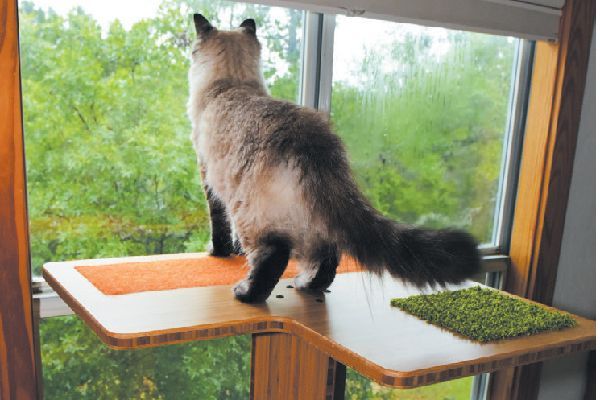Provide a Safe Space
Cats feel more comfortable when they have a dedicated space to retreat to that is quiet and free of too much commotion. This gives them a sense of security. Some ideas for creating a safe space for your cat include:
Set up a cat tower or cat tree, placed in an out-of-the way area, where your cat can perch up high and observe their surroundings from above. Cats like to climb, so giving them vertical space to hop up on helps them stake out their own territory (Source).

Provide boxes, tunnels, cat caves or enclosed cat beds for your cat to hide in when they want privacy or quiet time. Place these in low-traffic corners where your cat won’t be disturbed (Source).
Set up a “safe room” for your cat, ideally in a small space like a bathroom or closet. Furnish it with your cat’s bed, food, water, litter box and some toys so they have everything they need in one secure spot (Source).
Give Them a Place to Scratch
Cats have an instinctual need to scratch, so providing appropriate surfaces for them is key. Scratching posts and cardboard scratchers allow cats to satisfy their desire to scratch without damaging furniture. Places to scratch should have an enticing texture, like sisal rope, corrugated cardboard, or carpeting. Vertical scratching posts with different levels for cats to perch on are ideal. Some top-rated scratching posts include the SmartCat Ultimate Scratching Post and the Midwest Homes for Pets Sisal Cat Scratching Post.

It’s also important to trim your cat’s claws regularly to keep them blunt. This prevents extensive damage from scratching. Use trimmers designed specifically for cats and take care not to cut into the quick of the nail, which would be painful for your cat. Provide plenty of scratching surfaces and your cat is less likely to go after furniture and carpeting.
Offer Appropriate Toys
Cats need interactive toys that allow them to hunt, chase, and pounce. This satisfies their natural instincts and provides mental stimulation. Some great options include wand toys with feathers or other attachments that you can drag along the floor for your cat to stalk and pounce on. Catnip-filled mice or balls are also ideal for batting around and carrying in their mouths.
Rotating toys like the YOFUN Smart Interactive Cat Toy are fantastic for keeping your cat entertained when you’re not able to directly play with them. The ball spins in random directions to stimulate your cat’s natural hunting behavior. Having a variety of toys to rotate helps prevent boredom.
Tunnels, scratchers, and assorted cat toys provide different textures and environments for your cat to explore. Giving them opportunities for interactive play and exploration ensures your cat remains mentally and physically active.
Clean the Litter Box
Keeping your cat’s litter box clean is one of the most important things you can do to keep them comfortable. Cats are very fastidious creatures and a dirty litter box can cause them stress. Experts recommend scooping your cat’s litter box at least once per day. This helps remove urine clumps and solid waste, keeping odors at bay. According to veterinarians, you should replace all litter at least every two weeks, or sooner if you notice strong odors (How Often to Clean a Litter Box, According to Veterinarians).
When setting up the litter box, make sure it’s in a quiet, low-traffic area of your home. Your cat will appreciate privacy when doing their business. The general rule is one litter box per cat, plus an extra one. So if you have 2 cats, aim for 3 litter boxes. Boxes should be uncovered and easy for your cat to enter and exit. Make sure you thoroughly wash the litter box with soap and hot water each time you change the litter. This will help control germs.
By scooping daily and changing litter completely every week or two, you’ll help your cat feel relaxed and comfortable in their space.
Provide Plenty of Food and Water
Cats thrive on routine when it comes to their meals. It’s recommended to feed your cat 2-3 times per day to keep their metabolism active. Kittens and older cats may need to be fed more frequently. Feed your cat measured amounts of food rather than free feeding, which can lead to overeating and obesity. The average 10 lb adult cat needs about 1/3 to 1/2 cup of food per day, which equates to around 200-300 calories. The amount can vary based on your cat’s age, activity level, and other factors so consult your vet. Provide fresh, clean water at all times in a bowl that holds at least 12 oz. Cats are prone to dehydration so check frequently that they have adequate water available. Change the water daily and wash food and water bowls regularly with soap and hot water.
Source: How Much Should I Feed My Cat? | The Honest Kitchen
Give Them Affection
Cats thrive when they receive regular affection from their owners. Simple actions like petting, brushing, and playtime are great ways to bond with your cat and make them feel comfortable and content.
When petting your cat, focus on areas they enjoy like under the chin, cheeks, and base of the tail. Use long, gentle strokes and pay attention to their body language. If they start swishing their tail, pulling away, or acting annoyed, they’ve likely had enough petting for the moment. Make petting sessions a positive experience.
Brushing is another great way to give affection while keeping their coat healthy and free of knots. Introduce brushing slowly and use brushes designed specifically for cats. Make sure to brush gently and watch for signs your cat is not enjoying it. Regular brushing strengthens your bond through positive contact.
Playing with interactive toys is an excellent form of affection. Wand toys that allow you to engage your cat in chasing and pouncing are a great way to bond. Watch their body language for signs of overstimulation. Keep playtime positive by letting them “catch” the toy often.
Signs your cat is enjoying affection include purring, kneading, rubbing against you, relaxed posture, and slowly blinking eyes. Pay attention to their signals so you can provide the affection they crave in a way that makes them comfortable.
Keep Them Entertained
Cats need mental and physical stimulation to stay happy and healthy. There are many ways to keep your cat entertained and prevent boredom:
Suggest interactive play with toys like wands, laser pointers, and puzzles. Rotate toys to keep things interesting. Playtime is important for exercise and bonding. As the Animal Humane Society notes, interactive feeding puzzles can turn mealtime into an enriching game.
“Cat TV” can provide mental stimulation. Place bird feeders and aquariums near windows for your cat to watch. Consider DVDs designed for cat viewing.
Try catnip, which many cats find stimulating. Use catnip-filled toys or loose catnip. Just don’t overdo it, as cats can become desensitized.
Change up routines regularly to prevent boredom. Vary playtimes, introduce new toys, move furniture periodically, and offer new window perches or cat trees. A stimulating environment goes a long way in keeping cats entertained.
Allow Them to Explore
Cats are naturally curious creatures who like to investigate their surroundings. Providing safe ways for your cat to explore can help keep them mentally and physically stimulated. Here are some tips:
Encourage supervised outdoor access via a catio or leash walking. Building or buying a catio, which is an enclosed outdoor space for cats, allows them to experience fresh air and new sights and smells while keeping them safe. Walking your cat on a leash and harness also gives them outdoor adventure. Be sure to introduce leash training slowly and positively.
Have cat-safe houseplants. Many common houseplants can be toxic to cats, but there are cat-friendly options. Some good choices include spider plants, Boston ferns, African violets, prayer plants, air plants, and parsley. Keep plants out of reach to prevent chewing and research a plant’s safety before bringing it home. 21 Pet-Friendly Plants That Will Liven Up Your Space
Take Them to the Vet
Regular vet visits are crucial for ensuring your cat stays healthy and lives a long, happy life. Kittens should visit the vet every 3-4 weeks until they are 4 months old to receive vaccines, deworming, and general wellness checks as their immune system develops (Pumpkin). Adult cats should receive annual exams to screen for illnesses and obtain necessary vaccines like rabies (USA Today).

Watch for concerning signs that indicate illness and warrant a vet visit, including changes in eating, drinking, litter box use, activity level, or social behavior. Other red flags are vomiting, diarrhea, weight loss or gain, skin changes, oral issues like bad breath, and respiratory signs like coughing or sneezing. Don’t delay in seeking veterinary care if you notice anything out of the ordinary.
While annual exams are essential, you may need to visit the vet more often if your cat has a chronic condition requiring medication and monitoring. Overall, maintaining your relationship with a trusted vet and keeping up with preventative care is key to your cat’s health and contentment.
Be Patient and Understanding
Cats exhibit natural behaviors that may seem strange or undesirable to humans, but are completely normal for felines. As a cat owner, it’s important to be patient and take the time to understand your cat’s instincts.
For example, scratching is a normal cat behavior that allows them to remove dead layers from their claws and mark their territory with scent glands in their paws. Rather than punishing scratching, provide appropriate scratching posts around your home. Place them in key areas like entryways or near furniture to divert your cat’s scratching instincts.
Cats are natural hunters, so they may bat around toys, chase bugs, or pounce on ankles and hands. Redirect this energy into play sessions with fishing pole toys or puzzles feeders rather than scolding them. This allows them to indulge their predatory nature in a positive way.
Cats are also more independent than dogs, so they may not always seek affection or greet you at the door. Respect your cat’s space when they want alone time. With patience, you can build a bond of trust and help them become more sociable over time.
Additionally, use positive reinforcement training to encourage wanted behaviors. For example, give treats when they use a scratching post or their litter box. This is more effective than punishment and helps reinforce good habits.
Remember that much of your cat’s behavior stems from natural instincts. Have realistic expectations, and use kindness and consistency to build a happy, harmonious relationship.

